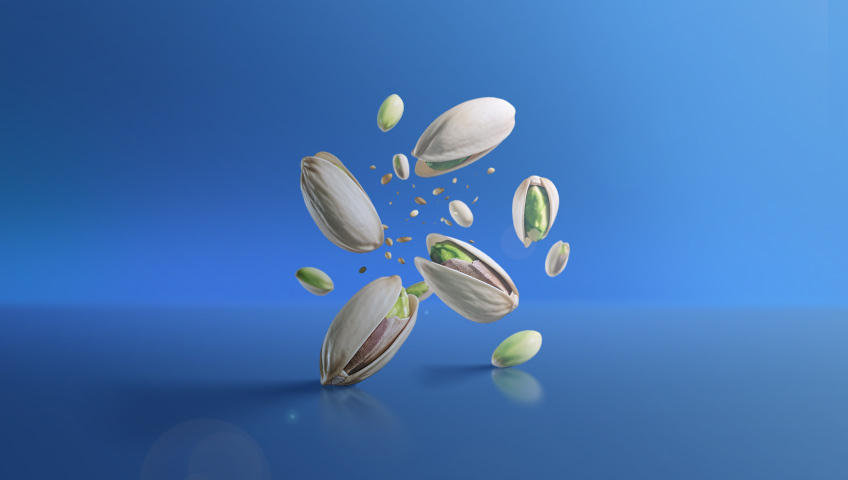2025.11.25
This article examines the position of Iranian pistachios in global markets and the challenges of their export, particularly contamination with fungal toxins and pesticide residues. In addition, it introduces the services that Marjaan Khatam Food Laboratory can provide in the field of pistachio export.
Introduction
Pistachio (Pistacia vera L.) has long held a special place in Iranian foods, traditional sweets, and cultural ceremonies. Moreover, pistachio is considered one of the most important agricultural and export products of Iran, carrying significant economic value.
A key characteristic of the pistachio tree is its high resistance to drought. Therefore, Iran’s hot and arid climate provides favorable conditions for pistachio production. For this reason, it is extensively cultivated in many desert and semi-desert regions of the country, particularly in Kerman Province and Rafsanjan County, which are regarded as major pistachio production hubs.
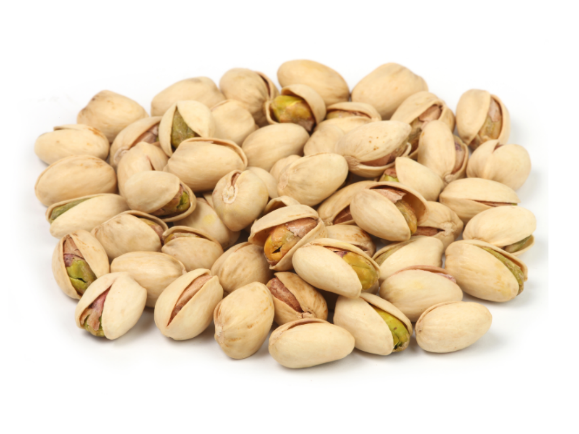
Pistachio Export
- History of Pistachio Export in Iran
Iranian pistachio is one of the country’s oldest and most valuable commercial commodities, with an export history dating back over 2,500 years to the Achaemenid era. Throughout different historical periods, pistachio has consistently been recognized as one of Iran’s most prized trade goods.
The organized export of Iranian pistachios began in the 1950s (1330s in the Iranian calendar). In the following decades, pistachio production exceeded domestic consumption, and a major portion of the crop was directed toward foreign markets, especially the United States. Alongside the U.S. market, efforts were also made to introduce Iranian pistachios in Europe. In 1965 (1344s in the Iranian calendar), with the establishment of a marketing office in Hamburg, Iranian pistachios gradually entered the European market. Limited exports were also made to countries such as Japan, Lebanon, and several Arab nations.
Today, pistachio is regarded as one of Iran’s key non-oil export commodities. Iranian pistachios are exported to numerous destinations, as shown in the table below:
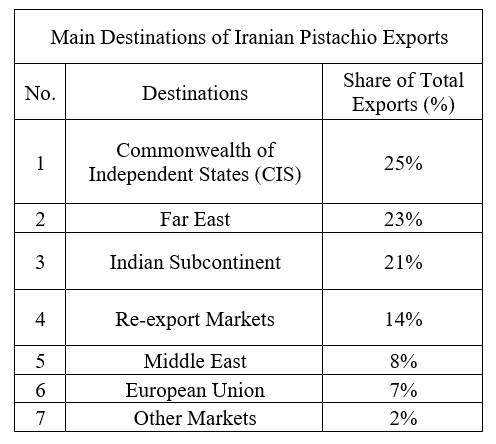
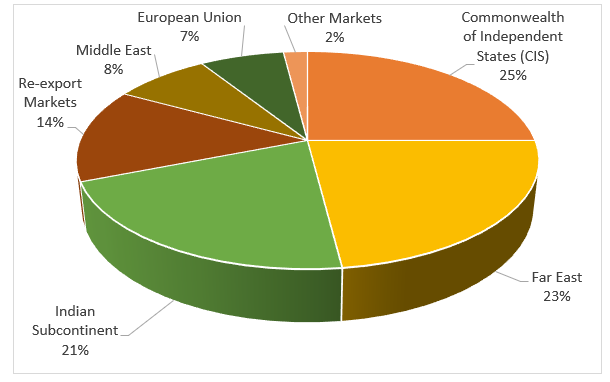
- Comparison of Iran’s Position with Global Competitors
Today, the major pistachio producers and exporters in the world are the United States, Iran, and Turkey, with their respective production volumes presented in the table below:
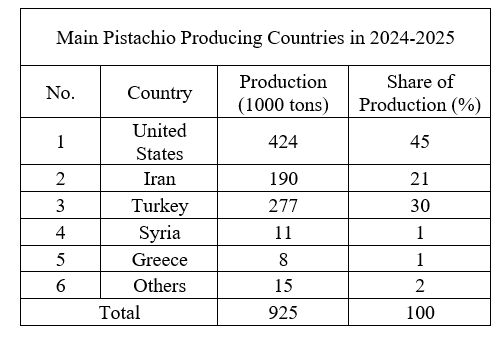
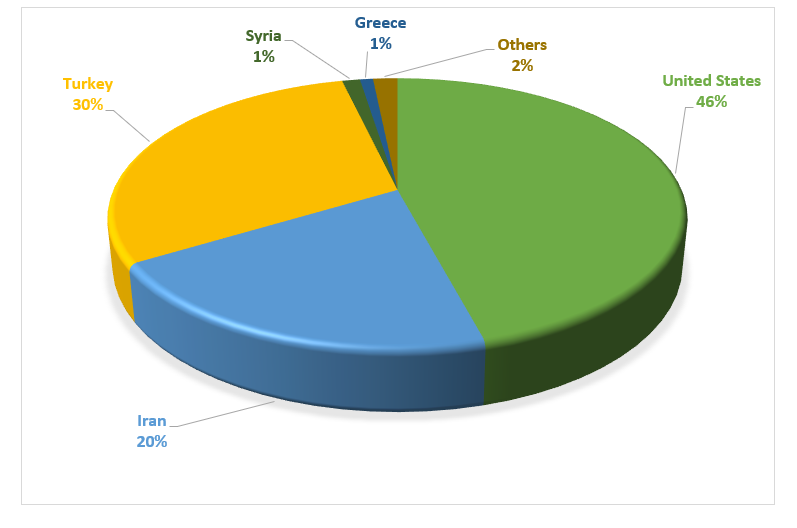
As can be seen in the table and chart, in 2024-2025 the United States holds the first rank, while Iran is in second place, although Iran held the top position until just a few years ago.
Below is a comparative chart of pistachio production between Iran and the United States:
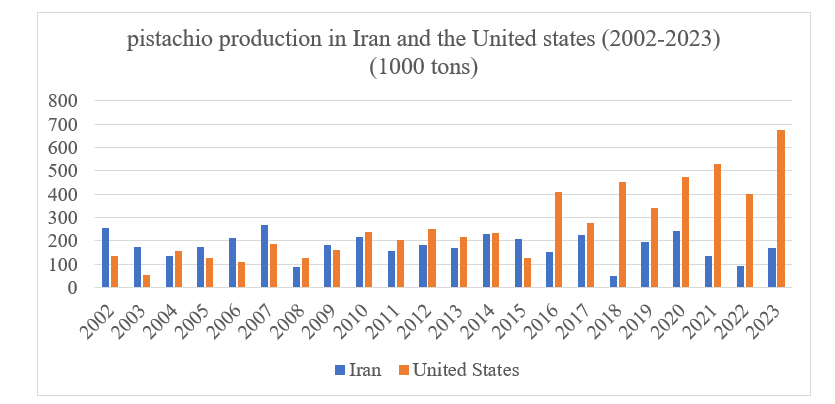
As shown in the chart, between the years 2002-2023, Iran's pistachio production decreased from 256,000 tons to approximately 168,000 tons, while during the same period, U.S. production increased from 137,000 tons to 677,000 tons.
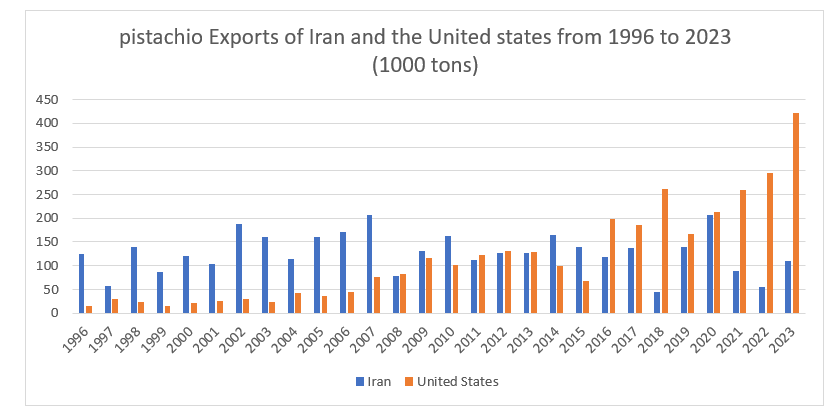
A comparative chart of pistachio exports from Iran and the United States, similar to the production chart, shows that in recent years the U.S. has overtaken Iran. As can be seen, Iran’s pistachio exports declined from 124 thousand tons in 1996 (1375 in the Iranian calendar) to 57 thousand tons in 2022 (1401 in the Iranian calendar), while U.S. exports increased from 15 thousand tons to 422 thousand tons.
Among the reasons for the decline in Iran’s pistachio production and exports are the following:
- Sanctions and foreign exchange restrictions: Sanctions and foreign exchange commitment requirements (the obligation of importers and exporters to return the equivalent foreign currency received back into the country) have prevented Iranian exporters from signing long-term fixed-price contracts, whereas the U.S. can sell pistachios under stable prices and long-term agreements.
- Inflation and high production costs in Iran: The high exchange rate and production costs have made Iranian pistachios expensive, preventing exporters from offering them at competitive prices in global markets.
- Rejected shipments: Quality and standardization issues have led to loss of markets and declining exports.
Pistachio exports are not only an important non-oil source of foreign exchange but also play a key role in job creation, economic development in pistachio growing regions, and maintaining Iran’s position in global markets. The reduction of Iran’s market share has significant economic consequences and allows international competitors such as the U.S. and Turkey to take advantage of market opportunities.
Common reasons for the rejection of Iranian pistachio exports
Iran’s pistachio exports face complex challenges in global markets, the most common being contamination with fungal toxins and pesticide residues. Given the strict regulations of global markets, effective control and management of contamination are essential for maintaining market share and ensuring the economic security of farmers and exporters. Familiarity with pistachio standards and acceptable limits of contaminants can help producers and exporters maintain quality and enhance Iran’s share in international markets.
- Fungal toxins and their acceptable limits in global markets
Pistachios, like other nuts, have relatively low moisture content after drying, which makes them more resistant to microbial spoilage. However, some fungi are capable of growing because they require very little water to reproduce. Fungal contamination can occur throughout the food chain during crop growth in the field, post-harvest stages such as drying, transportation, storage, and processing. This contamination is closely linked to environmental conditions such as temperature and humidity, with fungi growing more readily in warm and humid conditions.
In addition to environmental factors, damage to the product can also increase the risk of contamination. For example:
- Pistachios that split open early (so called "early-split pistachios") are more susceptible to fungal penetration and mycotoxin formation.
- Early-split pistachios with wrinkled and dry outer hulls are twice as likely to become contaminated compared to those with smooth and soft hulls.
- The presence of dark brown spots on the shell also increases the risk of contamination, although pistachios without visible spots may still contain fungal toxins.
Fungal growth in pistachios can lead to the production of mycotoxins. The word "mycotoxin" comes from the Greek word mykes (fungus) and the Latin word toxicum (poison). Long-term exposure to mycotoxins can damage the liver, kidneys, heart, blood vessels, and nervous system, and may cause cancer (especially liver cancer).
Pistachios contaminated with these toxins not only pose serious health risks for consumers but can also cause significant economic losses for producers if contamination levels exceed international standards, often resulting in rejected export shipments.
Reports from the Rapid Alert System for Food and Feed (RASFF) show that nuts particularly pistachios and almonds have the highest share of mycotoxin contamination. Among them, aflatoxin is the most common and significant mycotoxin, followed by ochratoxin A.
- Aflatoxin
Aflatoxin was first identified in the early 1960s as a fungal toxin with highly toxic and carcinogenic effects. It quickly became one of the most important food safety concerns worldwide. In 1971, the United States seized pistachios imported from Iran and Turkey due to aflatoxin contamination. Since then, the contamination of pistachios with aflatoxin has been under close scrutiny, and importing countries return shipments that exceed acceptable aflatoxin limits. In recent years, many shipments of Iranian pistachios have been rejected for this reason, causing significant financial losses for producers and exporters.
The number of rejected shipments from 2020 to 2024 is shown in the table below:
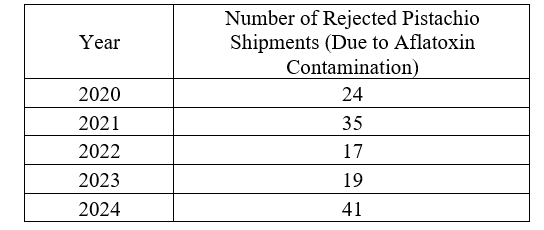
In the current year (2025), approximately 16 shipments of Iranian pistachios have been rejected by different countries.
The table below shows the list of rejected pistachio shipments in various months of 2025, along with the levels of contamination:
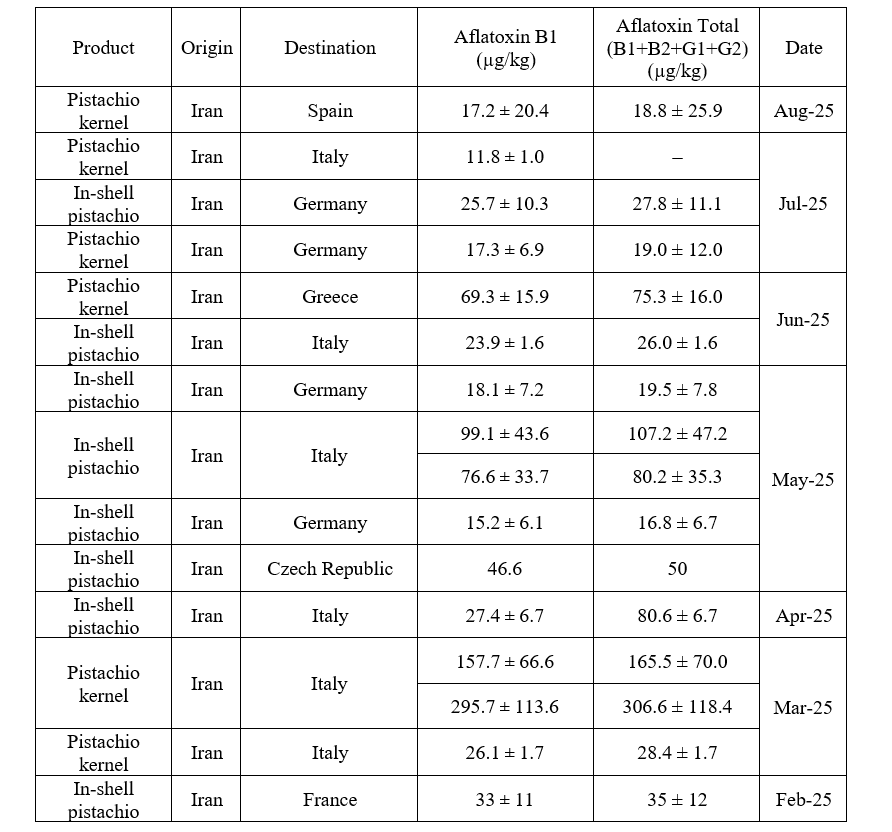
- Ochratoxin
In 2005, inspections carried out on 12 pistachio shipments exported to Europe revealed high levels of another fungal toxin called ochratoxin. The details of these shipments were as follows:
- 9 shipments from the United States with contamination levels ranging from 22 to 160 µg/kg
- 3 shipments from Iran with contamination levels ranging from 45 to 110 µg/kg
At that time, this issue drew attention to ochratoxin contamination in pistachios. Considering the risks ochratoxin poses to human health, some EU member states, including Germany and the Netherlands, attempted to convince the European Union to establish maximum limits for this toxin in pistachios. After years of review, in 2017 the EU officially initiated the process of setting maximum levels for ochratoxin. Finally, based on the decisions of the European Food Safety Authority (EFSA), the new regulations came into force in January 2023.
- Maximum Permissible Levels of Mycotoxins in Global Markets
Since the reduction or complete elimination of mycotoxins during pistachio processing is unlikely, failure to comply with maximum permissible levels not only endangers consumer health but also leads to the rejection of export shipments from global markets. Therefore, awareness of the regulatory limits of these toxins in different countries and strict control of their levels in pistachios are both logical and necessary approaches.
The maximum permissible levels of aflatoxins in different countries are presented in the following table:
.png)
.png)
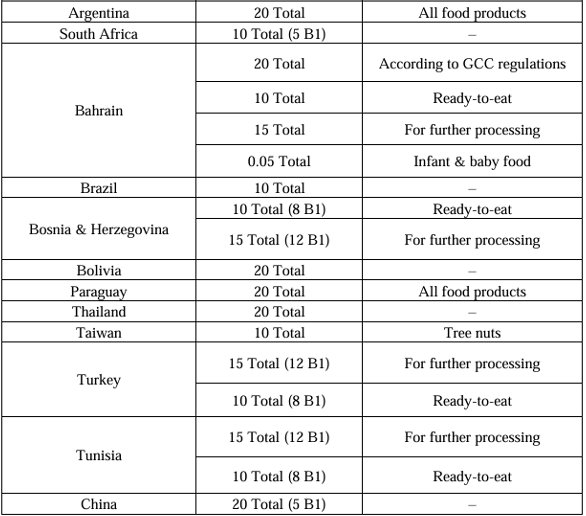
.png)
.png)
.png)
The maximum permissible levels of ochratoxin according to the European Union are presented in the table below:
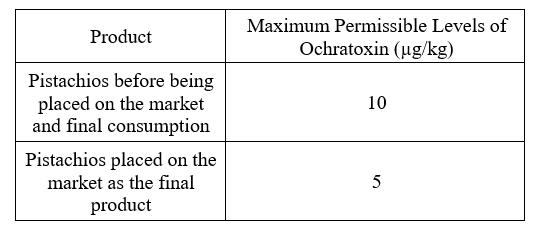
- Pesticide Residues and Their Maximum Permissible Levels in Global Markets
In addition to mycotoxins, the European Union also enforces strict regulations on pesticide residues in pistachios. This is because, from a scientific perspective, most pesticide residues in pistachios do not decrease significantly after harvest. Therefore, the EU may decide to destroy shipments containing pesticide residues to protect public health rather than return them to the country of origin, which can cause significant financial losses for exporters.
The use of chemical pesticides in pistachio orchards is common for pest control, prevention of plant diseases, and quality improvement. However, excessive use of pesticides can have serious consequences, including pest resistance, environmental contamination, and increased human health risks such as cancer, Alzheimer’s disease, cardiovascular disorders, autism, and developmental delays in children.
Given the importance of consumer safety, accurate measurement of pesticide residues and comparison with established maximum limits is essential. This ensures the safety of pistachios, protects human health, and reduces environmental impacts.
The following are the maximum permissible levels of pesticide residues according to Iranian and European Union standards:
- Maximum permissible pesticide residue levels according to Iranian standards
- Maximum permissible pesticide residue levels according to European Union standards
After accessing this link and selecting the product from the left panel, click on “Add selected”. Then, by choosing the desired pesticide from the right panel and clicking “Display selected items”, the maximum permissible level of that pesticide in the product will be displayed.
Marjaan Khatam Food Laboratory, Ensuring the Safety and Quality of Exported Pistachios
Marjaan Khatam Food Laboratory is a private knowledge-based company with over 23 years of specialized experience in food quality control. The laboratory operates through three domestic branches located in Tehran, Khorramshahr, and Bandar Imam Khomeini, as well as one international branch in Russia.
Through professional experts and advanced equipment, Marjaan Khatam Food Laboratory provides services related to pistachio exports. One of the most important services is the precise measurement of aflatoxin levels, which is not only one of the most critical fungal toxins in pistachios but also of great importance to many importing countries.
Considering the new EU regulations regarding ochratoxin, this laboratory was the first in Iran to measure ochratoxin levels in pistachios according to European standards and is now fully capable of providing these services.
Additionally, the laboratory can accurately measure pesticide residues using advanced instruments such as GC-MS and LC-MS/MS.
LOQ (Limit of Quantification) or the lowest concentration that our instruments can measure with acceptable accuracy and precision:
Marjaan Khatam Food Laboratory provides pistachio exporters with the opportunity to assess their products for fungal toxins and pesticide residues before shipment to destination countries.
The results from our laboratory are consistent with those obtained from laboratories in European countries, allowing exporters to proceed with greater confidence. Shipping pistachios without accurate testing can lead to shipment rejections and irreparable financial losses. Therefore, it is highly recommended that pistachio exporters have their products tested in reputable food laboratories before any export activity to minimize risks and ensure compliance with international safety standards.


